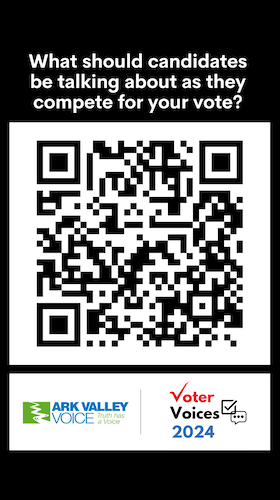With a growing interest in environmentally-friendly approaches to our trash, you might think that a recycling business would be a sure business model. Mickey and Jerrica Barry launched Angel of Shavano recycling 15 years ago. Through the years they have experienced the swings of a somewhat volatile recycling market.
“We’re more like farmers,” Mickey Barry said in an interview with Ark Valley Voice, “We build a commodity we can sell at market.”
According to Barry, the prices of recyclable materials wax and wane just like the market value of alfalfa or sweet corn. Like any market, the value of recyclable materials is driven by numerous things; including virgin oil prices, shipping costs and consumer habits.
What many consumers don’t understand is that the recycling market is quite complex. Not necessarily on the consumer end, but more so on the side of recycling companies.
China “forcing us to clean up our act”
Plastics are an example of the industry’s complexity. Plastics are numbered on a 1 to 7 basis. Each designation corresponds with a different type of plastic; be it a soda bottle, butter tub, Styrofoam packaging or a milk carton.

A guide to plastic recycling codes. Graphic courtesy of KS Environmental Group.
According to Barry, for years China has accepted these items practically unconditionally, creating a foundation for the recycling market. Recently, however, China started refusing shipments of recycling materials that were not diligently sorted.
China’s refusal of certain plastics has meant the saturation of the United States recycling market.
“The market (for plastics 3 to 7) has died because of China,” said Barry.
For Angel of Shavano, this means they are only recycling plastics that are designated 1 or 2, and not plastics 3 through 7.
Barry explained that 1 and 2 code plastics are typically bottles with a screw-on lid. Barry said that lid is the easiest way to distinguish 1 and 2 plastics from the rest (think soda bottles, milk jugs, Gatorade bottles, etc.).
While some might think China is being stingy or a difficult business partner, Barry said he sees the benefit in what China is doing and believes they have every right to do so. He pointed out the amount of trash and unclean materials of which the world has expected China to dispose of.
Currently, all recyclable material shipments to China undergo a thorough inspection before they are accepted. Every shipment is subject to an x-ray scan, as well as an inspection by a port-authority. These shipments are rejected if there is even a hint of contaminated material.
“What China is doing is actually good,” explained Barry. “It all comes down to quality. China doesn’t want it (recyclable materials) the way we are doing it. They don’t want our trash. They are forcing us to clean up our act.”
Sorting materials the key to recycling
By ‘cleaning up our act’ Barry is referring to the way recyclable materials are sorted and cleaned prior to being shipped to be recycled. This has serious implications on a material’s recycling viability.
The most common way to collect recyclable materials in the United States is called ‘single stream’ recycling. This method of collection requires consumers to dump all recyclable materials into a single stream; with additional sorting taking place at a recycling plant. Barry says that this collection method often leads to higher contamination levels in recycling shipments.
Angel of Shavano utilizes a ‘source separated’ collection method. With four main drop sites throughout the county (Buena Vista, Salida, the Chaffee County Landfill and Poncha Springs), Angel of Shavano collects plastics, metals, cardboard, paper and glass. Each of the sites has designated containers for each type of recyclable materials.
Theoretically, Chaffee County is ahead of the curve in transitioning to a cleaner, more efficient recycling process. But oftentimes recycling streams are contaminated, including the county’s ‘source separated’ collection method. Most of the time these recycling streams are contaminated by food matter and liquids.
“Really, what it comes down to is laziness,” said Barry, referencing how consumers dump uncleaned plastic tubs, half-empty bottles, and half-eaten snacks into recycling bins.
Still, Barry recognizes how recycling can sometimes spiral into an abyss of confusion and uncertainty for consumers.
“It’s really easy to overthink recycling,” Barry pointed out. “We put everything you need to know (about recycling) on signs at the drop sites.”
Cost-effectiveness a major hurdle
China’s recent and continuing refusal to accept unsorted and contaminated plastics has essentially dried up the market for plastics 3 through 7. It’s not that China won’t take these materials, but that the recycling content must be thoroughly sorted and free of contaminants.
Barry says the problem with more thorough sorting is that it takes more time, and more time means more money. Angel of Shavano, said Barry, simply cannot pay someone to sort through plastics 3 through 7 and ship them to China. These plastics (think Styrofoam, yogurt cups, bread bags and shrink wrap) take over a year’s worth of sorting to accumulate the minimum shipment size of 40,000 lb.; not to mention the current low return on plastics 3 through 7, which is only half-a-penny per pound on these plastics.
Instead of income, Angel of Shavano is spending $1,000 per week to dispose of the 3 through 7 plastics it collects at its drop sites.
The consequences of consumerism
During a tour of the Angel of Shavano recycling facility, Barry pointed out that glass can be endlessly recycled – making it an ideal recyclable. Plastic, however, can only be recycled once.
One may ask; why do we use plastic at all? Instead, we could endlessly recycle glass and limit our use of plastics.
Barry has a simple, one-word answer: consumerism. Using a ketchup bottle as an example, Barry outlined the ways in which the adoption of plastic bottles is driven by consumer habits, and how changing materials affects the financial implications of recycling.
For example, says Barry, shipping plastic bottles is considered better than shipping glass, because plastic is lighter and more durable. Thus, less revenue is lost in broken bottles and more bottles can be shipped with every shipment. This keeps shipping costs down and lower costs trickle all the way to the retail value.
Barry pointed out how much easier it is to squeeze ketchup (or any condiment) from a plastic bottle than pouring it from a glass one.
These things drove down the demand for glass bottles and increased the demand for plastic bottles. Now, plastic pollution is one of the great environmental challenges with which the globe must contend.
As Barry pointed out, recyclable materials are a commodity. Consumers need to understand how damaging it is to place uncleaned recyclable materials in bins at drop sites or place the materials in the incorrect bin. Consumers drive the demand for different materials, so if change happens, it will begin with consumers.
“Do you know why beer is still sold in glass bottle instead of plastic?” asked Barry. He believes it is because consumers will not buy beer in a plastic bottle as they believe it tastes better out of a glass bottle. Thus, beer companies continue to sell glass-bottled beer.
Barry uses the same reasoning for soda. “The best Mountain Dew I ever had came out of a glass bottle,” said Barry.






A timely topic, yet this story is much more compelling than even that of recent articles in the New York Times and Wall Street Journal. Why? Because the writer dug deep into the angle provided by the local recycler, Angel of Shavano. Mickey Barry points out the hard realities of supply and demand affecting us in Chaffee County.
What’s captured as newsworthy here is that Mr. Barry also makes a personal connection with all of us and our responsibilities as consumers. Without shaming anyone he calls attention to what lazy sorting or unwashed plastics does to local landfills, impacting the recycler’s ability to stay in business and providing us with a great service. That the recycler has to PAY to dump the #3 through #7 plastics, after our sorting them is discouraging, to say the least.
Clearly we must do more to reduce the use of plastics in the first place and compel industry to choose higher value materials with greater reuse potential (glass) or less landfill impact. Plant-based containers, anyone? Local governments also can help with education and incentives to encourage highest and best participation.
The “Our Mother Earth Day Parade and Festival”, organized by 350 Central Colorado is scheduled for May 4th at Riverside Park, Salida. In addition to family activities and entertainment, there will be educational booths. This would be a great opportunity for a wider audience to hear more about recycling realities and how it all starts with each of us at home.
I hope we will see more great coverage on topics like this in the Ark Valley Voice. Henry John DeKam is a fine writer and great addition to the staff!
Hi Merrell,
Thank you for your feedback! We enjoy delivering quality content to the Arkansas Valley. I, personally, agree with you that reducing or eliminating our use of plastics is critical to environmental health moving forward. Moreover, single-use plastics and their prevalence is a serious issue within the greater concern of our use of plastic products. I know there are counties in Colorado and in the United States who have outlawed the use of some plastics; including plastic shopping bags. It will be interesting to see how the conversations around this issue progress. Hopefully, they will progress into further action!